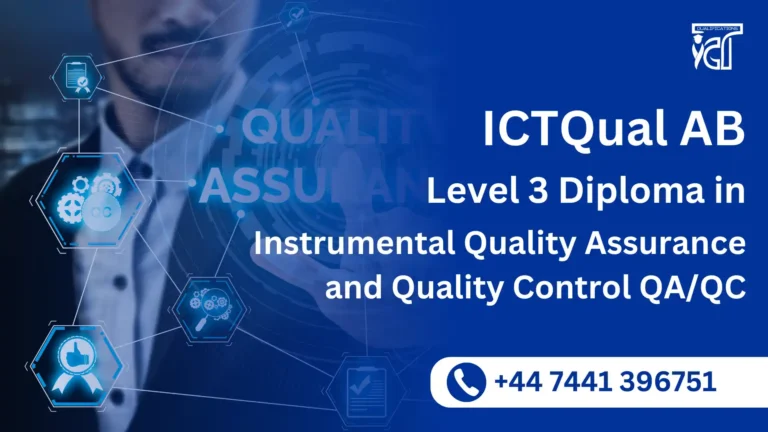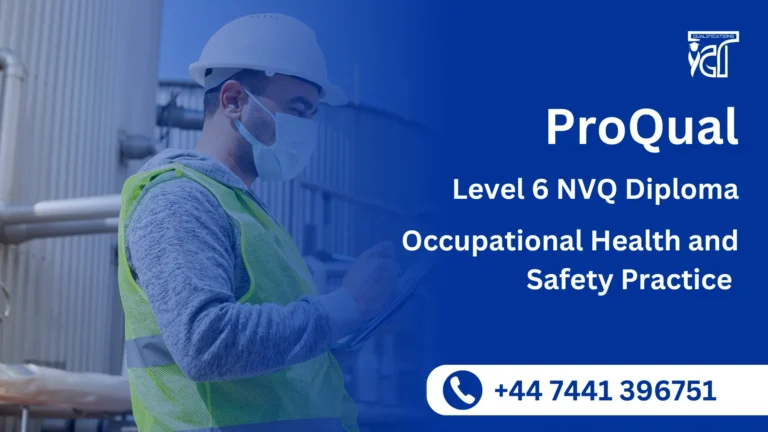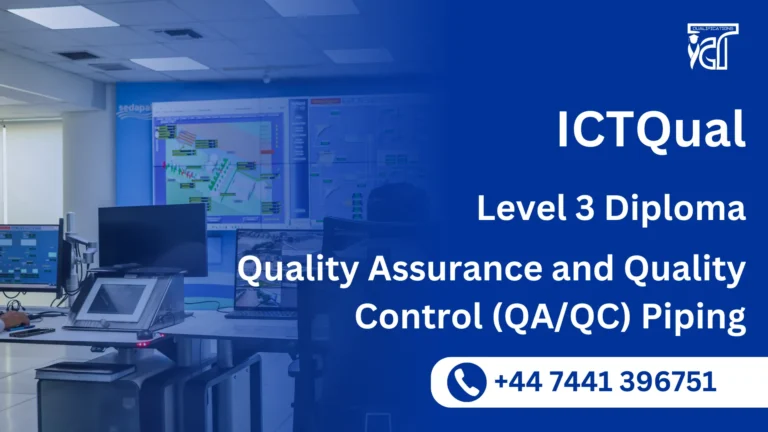Workplace safety is a critical aspect of any industry, and professionals responsible for ensuring health and safety compliance must possess the right qualifications. The NOCN Level 3 NVQ Certificate in Occupational Health and Safety is an Ofqual-regulated qualification designed to equip individuals with the knowledge and skills required to maintain a safe working environment.
This assignment-based qualification is ideal for those working in health and safety roles and seeking a formal certification without exams. Whether you are starting your career in health and safety or looking to progress within your organization, this NVQ certificate provides a solid foundation.
The NOCN Level 3 NVQ Certificate in Occupational Health and Safety is a competency-based qualification that assesses a learner’s ability to manage workplace health and safety responsibilities. As it is based on real work activities, learners are required to demonstrate their knowledge and competence through workplace evidence and written assignments rather than traditional exams.
The NOCN Level 3 NVQ Certificate in Occupational Health and Safety is an excellent qualification for individuals looking to enhance their knowledge and career prospects in workplace health and safety. With its flexible, assignment-based approach, it provides an accessible and practical route to professional development.
NOCN Level 3 NVQ Certificate in Occupational Health and Safety
NOCN Level 3 NVQ Certificate in Occupational Health and Safety training program consist of 9 mandatory units of 32 credits, 320 TQT (Total Qualification time).
Mandatory units
| Sr# | Unit Title | Credits | GLH |
|---|---|---|---|
| 1 | Awareness of Hazards in the Workplace | 4 | 34 |
| 2 | Comply with Health and Safety Requirements in the Workplace | 4 | 34 |
| 3 | Conduct a Health and Safety Risk Assessment of a Workplace | 6 | 48 |
| 4 | Control Work Operations Safely | 5 | 40 |
| 5 | Develop Procedures to Safely Control Work Operations | 4 | 30 |
| 6 | Investigate and Evaluate Health and Safety Incidents and Complaints at Work | 6 | 48 |
| 7 | Personal Actions to Reduce Risks to Health and Safety | 4 | 34 |
| 8 | Review Health and Safety Procedures at Workplaces Other Than Their Own | 5 | 40 |
| 9 | Supervise Health, Safety and Welfare of Individuals at Work | 5 | 38 |
GLH (Guided Learning Hours) and TQT (Total Qualification Time) are terms commonly used in vocational qualifications to help define the amount of time a learner is expected to spend on heir studies.
1. GLH (Guided Learning Hours)
GLH refers to the number of hours a learner spends being directly taught, supervised, or supported during their course. This includes the time spent in activities such as:
- Classroom instruction
- Practical workshops
- One-on-one tutoring or mentoring sessions
- Online learning sessions with tutor support
In other words, GLH represents the time that learners are actively engaged with their instructors or learning activities.
2. TQT (Total Qualification Time)
TQT represents the total amount of time a learner is expected to invest in completing a qualification, including:
- GLH (Guided Learning Hours): Time spent on direct learning, as explained above.
- Self-Directed Learning: This includes time spent on independent study, research, assignment completion, preparation for exams, and any other work the learner does outside of direct teaching hours.
TQT is a broader measure that includes all the time required to achieve the qualification. It helps learners and employers understand the overall commitment required for the qualification.
Key Differences Between GLH and TQT:
- GLH focuses on direct learning with guidance or supervision.
- TQT includes GLH as well as independent study time and other learning-related activities.
Example:
If a qualification has a TQT of 600 hours and a GLH of 250 hours, it means the learner should spend 250 hours in direct learning (classroom, online, or tutor-led sessions) and 350 hours on independent study or research.
Learning Outcomes of NOCN Level 3 NVQ Certificate in Occupational Health and Safety
1. Awareness of Hazards in the Workplace
- Identify common workplace hazards and risks.
- Understand the potential consequences of workplace hazards.
- Recognize employer and employee responsibilities for hazard control.
- Implement basic hazard identification techniques.
2. Comply with Health and Safety Requirements in the Workplace
- Understand and follow workplace health and safety policies.
- Ensure personal actions align with legal and organizational safety requirements.
- Demonstrate compliance with safety procedures and use of PPE.
- Report health and safety concerns effectively.
3. Conduct a Health and Safety Risk Assessment of a Workplace
- Understand the principles of risk assessment.
- Identify workplace hazards and assess associated risks.
- Apply control measures to minimize risk.
- Record and review risk assessments to ensure effectiveness.
4. Control Work Operations Safely
- Monitor work activities to maintain compliance with safety regulations.
- Implement risk control measures to prevent workplace incidents.
- Ensure all staff follow correct safety procedures.
- Promote a safe working environment through supervision and communication.
5. Develop Procedures to Safely Control Work Operations
- Create safe work procedures to minimize hazards.
- Ensure compliance with legal and industry safety standards.
- Communicate safety procedures effectively to employees.
- Regularly review and update safety procedures based on operational needs.
6. Investigate and Evaluate Health and Safety Incidents and Complaints at Work
- Understand the importance of incident investigations.
- Collect and analyze evidence following workplace incidents.
- Identify root causes and recommend corrective actions.
- Report findings and implement improvements to prevent recurrence.
7. Personal Actions to Reduce Risks to Health and Safety
- Demonstrate awareness of personal responsibility in workplace safety.
- Identify and report unsafe practices or conditions.
- Follow best practices to minimize personal health and safety risks.
- Maintain a proactive approach to workplace safety.
8. Review Health and Safety Procedures at Workplaces Other Than Their Own
- Conduct assessments of external workplaces for safety compliance.
- Identify potential hazards and suggest control measures.
- Compare and analyze safety standards across different environments.
- Recommend improvements based on observed health and safety practices.
9. Supervise Health, Safety, and Welfare of Individuals at Work
- Provide clear guidance and instruction on workplace safety.
- Ensure employees follow health and safety policies.
- Monitor welfare provisions, such as first aid and ergonomics.
- Identify and address unsafe behaviors or working conditions.
Course Benefits of the NOCN Level 3 NVQ Certificate in Occupational Health and Safety
The NOCN Level 3 NVQ Certificate in Occupational Health and Safety offers numerous advantages for individuals and organizations looking to enhance workplace safety standards. This Ofqual-regulated, assignment-based qualification provides a flexible, practical approach to developing essential health and safety skills.
Key Benefits of the Course
1. Recognized and Respected Qualification
- This Level 3 NVQ Certificate is regulated by Ofqual, making it a highly credible qualification recognized by employers across various industries.
- Enhances professional credibility and can support applications for health and safety job roles.
2. 100% Assignment-Based – No Exams
- Unlike other health and safety courses, this NVQ is assessed through practical assignments and workplace evidence rather than written exams.
- Ideal for learners who prefer hands-on learning rather than academic-style assessments.
3. Career Progression and Professional Development
- Provides a clear pathway to higher qualifications, such as the NOCN Level 6 NVQ Diploma in Occupational Health and Safety Practice.
- Helps individuals qualify for professional membership with institutions like IOSH (Institute of Occupational Safety and Health).
4. Improved Job Opportunities & Career Security
- Enhances employability for roles such as Health and Safety Officer, Supervisor, or Coordinator.
- A valuable asset for anyone looking to move into health and safety leadership positions.
5. Flexible Learning – Study While You Work
- Designed to be completed alongside full-time employment, allowing learners to apply their knowledge directly to their workplace.
- No fixed study hours, giving learners the flexibility to complete assignments at their own pace.
6. Helps Organizations Improve Workplace Safety
- Equips employees with the knowledge and skills to reduce workplace risks, prevent accidents, and ensure compliance with health and safety regulations.
- Supports employers in meeting legal health and safety requirements.
7. Builds Confidence in Managing Health & Safety
- Develops practical skills in risk assessment, incident investigation, hazard control, and health & safety compliance.
- Enables learners to confidently implement and supervise safety measures in their workplace.
8. No Formal Entry Requirements
Suitable for beginners or professionals looking to enhance their knowledge.
Open to individuals with no prior qualifications in health and safety.
The NOCN Level 3 NVQ Certificate in Occupational Health and Safety is designed for individuals who are either starting their career in health and safety or those who already have experience in the field and wish to formalize their knowledge. This qualification is ideal for those seeking to develop their skills and understanding of workplace health and safety practices, with the flexibility to learn through practical assignments and real-life applications.
Who This Qualification is For:
- Health and Safety Officers/Representatives:
Professionals already working in a health and safety role who want to formalize their qualifications and enhance their career prospects. - Supervisors/Managers with Health and Safety Responsibilities:
Supervisors or team leaders who are responsible for maintaining health and safety standards in the workplace, ensuring safe working practices and employee welfare. - Aspiring Health and Safety Professionals:
Individuals looking to transition into the health and safety field from another sector or role, and those interested in pursuing a career in occupational health and safety. - Those in Operational or Technical Roles:
Employees involved in managing or assessing risk, conducting safety audits, or handling compliance matters, who want to gain a recognized qualification in health and safety.
Ideal Learner Characteristics:
- Experience in a Health and Safety-Related Role:
While the course is open to newcomers, it’s especially suited for individuals who already have some experience or responsibility for health and safety practices in their current job. This could include conducting risk assessments, following safety protocols, or managing compliance. - Practical and Hands-On Learners:
The course is entirely assignment-based, meaning learners will need to engage with real-world scenarios and demonstrate their competence in workplace activities. Ideal candidates will be comfortable learning through practical assignments rather than traditional exams. - Goal-Oriented and Proactive:
Ideal learners are motivated to improve workplace safety and reduce risks. They will be proactive in identifying hazards and will want to gain the tools and knowledge needed to manage health and safety systems effectively. - Looking for Career Advancement or Certification:
Those seeking to enhance their career opportunities, increase job security, and gain formal qualifications in health and safety, whether for a promotion within their organization or to transition into a new role. - Organized and Detail-Oriented:
Learners should have an attention to detail, as they will be required to document safety audits, risk assessments, and incident reports as part of their assessment.
Not Ideal for:
- Individuals without a current role or significant experience in health and safety or an operational/technical role that involves workplace safety.
- Learners who prefer classroom-based learning or need structured learning environments with scheduled exams.
The NOCN Level 3 NVQ Certificate in Occupational Health and Safety is perfect for professionals looking to gain a formal qualification in health and safety, particularly those already working in related fields or wishing to move into health and safety management. It is designed for practical learners who want to develop and demonstrate their competency in real-world scenarios while improving their career prospects
Entry Requirements
Register Now
Qualification Process
Qualification Process NOCN Level 3 NVQ Certificate in Occupational Health and Safety
- Self-Assessment:
Begin by evaluating your eligibility to ensure you meet the qualification requirements, including work experience, knowledge, and language proficiency. - Registration:
Complete your registration by submitting the required documents, including a scanned copy of a valid ID, and paying the registration fee. - Induction:
An assessor will conduct an induction to confirm your eligibility for the course and explain the evidence requirements. If you do not meet the criteria, your registration will be canceled, and the fee will be refunded. - Assignments & Evidence Submission:
Provide all assignments and the necessary evidence based on the assessment criteria outlined in the course. If you are unsure of the required evidence, consult with the assessor for guidance on the type and nature of evidence needed. - Feedback and Revision:
The assessor will review your submitted evidence and provide feedback. Evidence that meets the criteria will be marked as “Criteria Met,” while any gaps will be identified. You will be asked to revise and resubmit if needed. - Competence Evidence:
Submit final evidence demonstrating that all learning outcomes have been met. This evidence will be marked as “Criteria Met” by the assessor once it is satisfactory. - Internal Quality Assurance (IQA):
The Internal Quality Assurance Verifier (IQA) will review your evidence to ensure consistency, quality, and compliance with standards. - External Verification:
The IQA will submit your portfolio to NOCN External Quality Assurance Versifier (EQA) for final confirmation. The EQA may contact you directly to verify the authenticity of your evidence. - Certification:
Upon successful completion of all checks, NOCN will issue your official certificate, confirming that you have attained the NOCN Level 3 NVQ Certificate in Occupational Health and Safety







